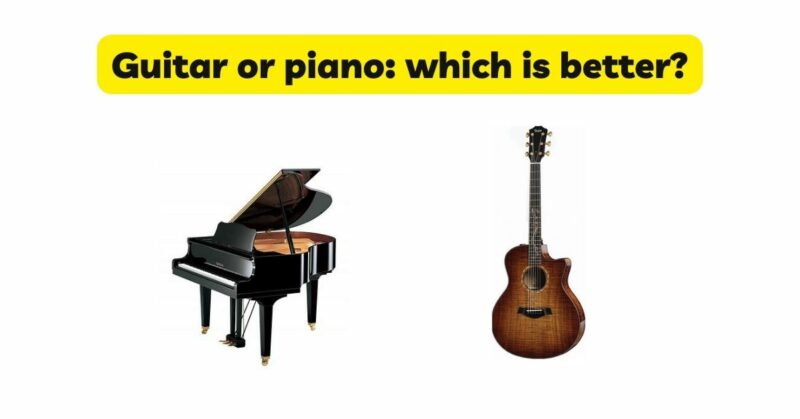The guitar and piano are two iconic instruments that have captivated musicians and audiences alike for generations. Each instrument possesses its unique qualities, and the question of which is better ultimately comes down to individual preferences, musical goals, and the desired musical experience. In this article, we will explore the strengths and characteristics of the guitar and piano, discussing factors such as versatility, expressiveness, learning curves, and cultural significance. By understanding the distinct qualities of each instrument, readers can gain insights into which instrument may be better suited for their musical aspirations.
- Versatility: The Guitar’s Chameleon-like Nature: The guitar is renowned for its versatility, able to adapt to a wide range of musical genres. From folk and blues to rock and pop, the guitar’s ability to strum chords, pick melodies, and create captivating solos makes it a go-to instrument for many musicians. Its portable size also adds to its versatility, allowing for impromptu jam sessions and performances in various settings. The guitar’s ability to accompany both vocals and other instruments makes it a versatile choice for songwriting and ensemble playing.
- Expressiveness: The Piano’s Dynamic Range: The piano, with its full range of octaves and expressive capabilities, offers a unique avenue for musical expression. Its dynamic touch-sensitive keys allow for nuanced playing, from delicate pianissimos to thundering fortissimos. The piano’s polyphonic nature enables the simultaneous playing of melodies, harmonies, and basslines, providing a rich and immersive musical experience. Its versatility in dynamics and tonal range lends itself well to classical music, jazz, and other genres that demand intricate musical expression.
- Learning Curves: Piano’s Precision and Guitar’s Intuitive Appeal: The learning curves of the guitar and piano present distinct challenges. The piano requires precise finger coordination, hand independence, and an understanding of both treble and bass clefs. Its visual layout facilitates music theory comprehension, but technical proficiency may take time to develop. The guitar, with its fretboard and chord shapes, appeals to many due to its intuitive nature. While chord changes and finger coordination present initial hurdles, the guitar’s approachability makes it enticing for beginners.
- Cultural Significance: Piano’s Grand Legacy and Guitar’s Popularity: Both the piano and guitar have played significant roles in shaping music history and popular culture. The piano, with its associations with classical music and the grandeur of concert halls, carries a sense of tradition and refinement. It has been a vehicle for musical genius throughout the centuries. The guitar, on the other hand, has an undeniable place in popular music, carrying the spirit of rebellion and self-expression. Its cultural significance extends across genres and has shaped the sound of rock, blues, and various contemporary styles.
- Solo vs. Ensemble Playing: Piano’s Standalone Power and Guitar’s Collaborative Spirit: The piano’s ability to play melodies, harmonies, and basslines simultaneously makes it a powerful instrument for solo performances. Its self-sufficiency allows for complete musical expression in a standalone setting. The guitar, while equally capable of solo performances, often thrives in ensemble contexts. Its versatility in rhythm playing, lead melodies, and improvisation makes it an ideal instrument for collaborating with other musicians and participating in band settings.
- Portability and Accessibility: Guitar’s Advantageous Mobility: The portability of an instrument can greatly impact its accessibility and practicality. Guitars, particularly acoustic or smaller-bodied models, are more easily transportable compared to pianos. This mobility allows guitarists to play in various environments, participate in impromptu jam sessions, and bring their instrument wherever they go. Pianos, while offering digital alternatives and portable keyboard options, require more space and logistical considerations, limiting their accessibility in certain situations.
- Personal Preferences and Musical Goals: Determining which instrument is better ultimately comes down to personal preferences and musical goals. Some individuals may gravitate towards the piano’s expressive capabilities, its ability to tackle classical repertoire, and its solo performance potential. Others may be drawn to the guitar’s versatility, its role in popular music, and the collaborative possibilities it offers. Choosing the instrument that resonates with personal interests and aligns with musical aspirations ensures a more fulfilling and rewarding musical journey.
- Continuing Development and Growth: Ultimately, the question of which instrument is better should be reframed to focus on the ongoing musical development and growth that each instrument can provide. Both the guitar and piano offer endless possibilities for exploration, creative expression, and personal growth as a musician. Continual learning, practice, and a willingness to explore new genres and techniques are key to unlocking the full potential of either instrument.
Conclusion: In the debate of whether the guitar or piano is better, the answer lies in personal preferences, musical goals, and the desired musical experience. The guitar’s versatility, portability, and intuitive appeal make it a favorite choice for many musicians, especially those seeking to explore contemporary genres and collaborate with other artists. The piano’s expressive capabilities, dynamic range, and rich cultural heritage make it a compelling choice for those drawn to classical music, solo performances, and intricate musical expression. Ultimately, the “better” instrument is the one that resonates with individual interests, inspires creativity, and ignites a passion for making music. Both the guitar and piano have their unique strengths, allowing musicians to embark on enchanting musical journeys that are as diverse as the notes they play.


